“Is your little one always reaching for a sweet treat?”
If so, you’re definitely not alone. Many parents find themselves constantly battling their child’s urge to eat sweets, especially after meals or during snack time. But while an occasional dessert is perfectly fine, excess consumption of sugar can lead to long-term health concerns—ranging from childhood obesity and diabetes to dental issues and behavioural changes.
What’s often overlooked is that sugar cravings in children aren’t just about liking sweet flavours. There are multiple reasons for craving sugar, including fluctuating blood sugar levels, lack of essential nutrients, and even emotional triggers like boredom or stress. Unfortunately, most packaged foods marketed to kids are loaded with hidden sugars, making it harder for parents to control sugar cravings effectively.
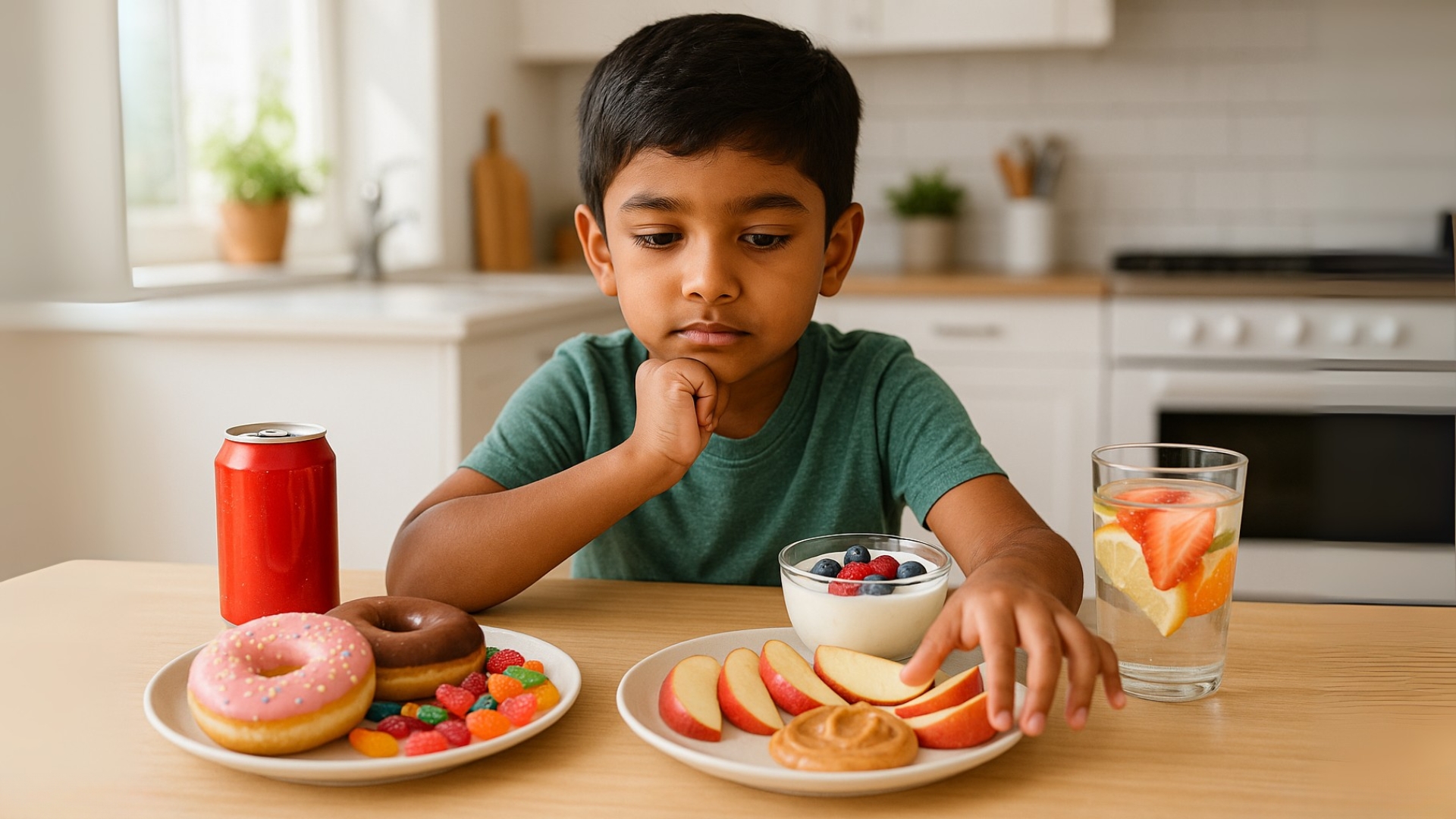
This is why building mindful eating habits from an early age is not just important—it’s essential. Early dietary interventions can set the foundation for a lifetime of healthy choices. By introducing healthy snacks and foods that reduce sugar cravings, you can help your child develop a more balanced relationship with food.
The good news? You don’t have to deprive your child to make this change. With the right approach and a few smart swaps, you can reduce sugar intake without sacrificing taste. Whether it’s switching to a better sugar substitute or curating a daily meal plan, there are plenty of ways to satisfy the sweet tooth in a nourishing way.
Let’s explore how to tame those always crave sugar moments—without the sugar crash that follows.
What are the Reasons for Sugar Craving in Kids?
If you’ve noticed your child always crave sugar, especially at night, it’s not just about having a “sweet tooth.” Several biological, environmental, and emotional factors are at play. Let’s break down the main reasons for craving sugar in children:
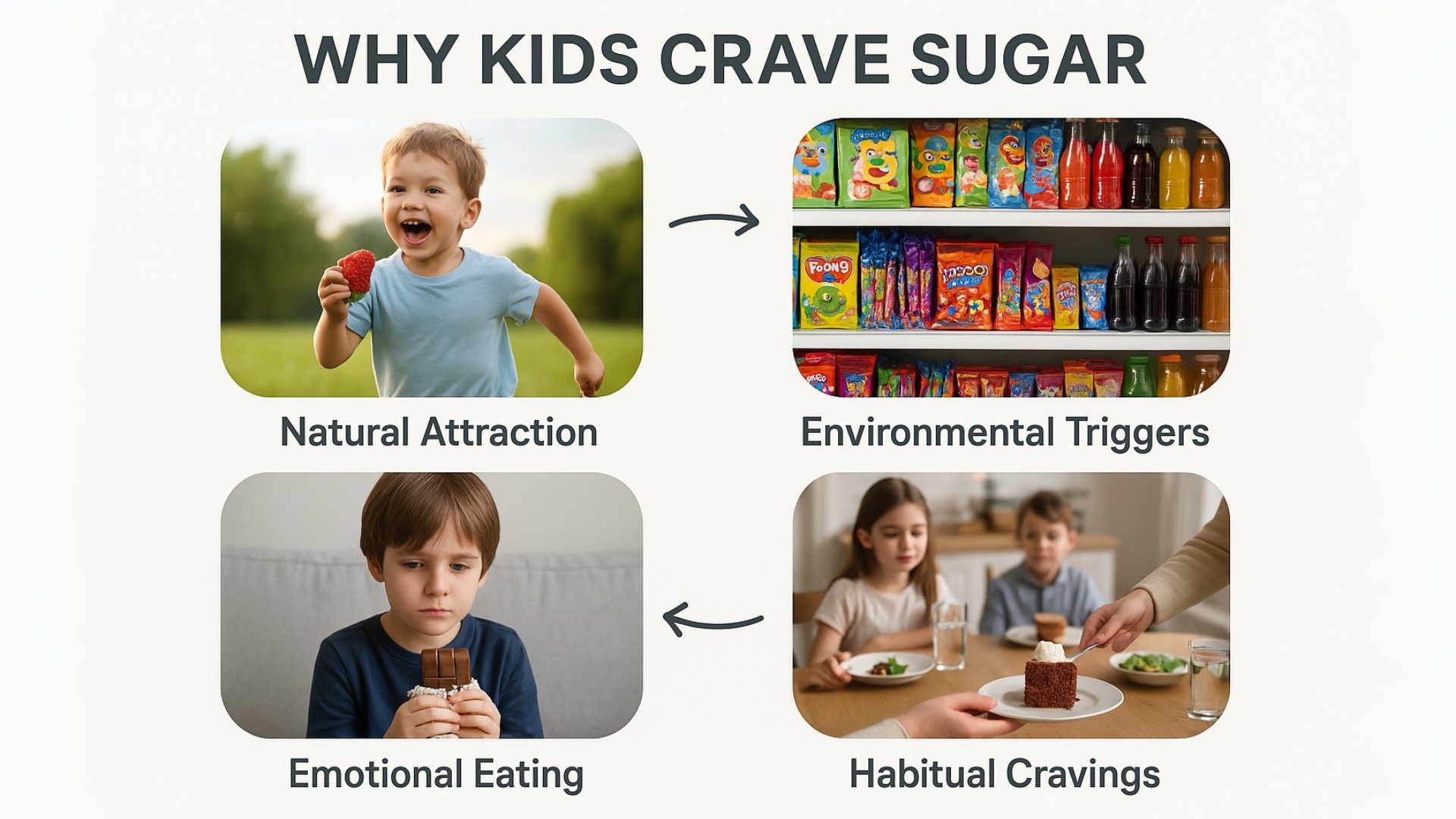
Natural Attraction to Sweetness (Evolutionary Biology)
- Human beings are biologically programmed to enjoy sweet flavours. In early human history, sweet foods like fruits were safe and provided quick energy.
- For growing children, the body instinctively seeks out energy-rich foods to fuel rapid development and activity—leading to strong sugar cravings.
- This natural preference becomes problematic today, where excess consumption of sugar is easy due to modern, sugar-heavy diets.
Environmental Triggers
- Processed snacks, sugary beverages, and candies are heavily marketed to kids, especially through TV ads, YouTube, and mobile games.
- Bright packaging, cartoon characters, and peer influence at school make these sugary options more appealing.
- Children are often surrounded by sugar-rich options, so the constant exposure increases the urge to eat sweets and makes it harder to resist.
Emotional Eating Patterns
- Many kids turn to sweets when they’re feeling bored, stressed, or upset. Sugar stimulates the brain’s pleasure center, offering temporary comfort.
- Emotional associations—like receiving chocolates for good behaviour—teach children to seek sweets as a coping mechanism.
- This emotional dependency can cause sugar cravings at night, especially if the child uses food as a reward or soothing tool before bedtime.
Habitual or Routine-Based Cravings
- If a child is used to getting dessert after every meal or sugary snacks between classes, their body begins to expect it.
- Over time, this routine reinforces a cycle where they always crave sugar, regardless of hunger or need.
- Breaking this habit requires introducing structured eating patterns and foods that reduce sugar cravings.
Recognizing these triggers is the first step toward helping your child develop a healthier relationship with food. By understanding the reasons for craving sugar, you can begin to shift habits and reduce reliance on unhealthy snacks.
Health Impact of Excessive Consumption of Sugar on Children
While occasional treats are harmless, the excess consumption of sugar in children has become a growing concern. Beyond satisfying sugar cravings, regular intake of sugary foods can disrupt a child’s physical, mental, and emotional well-being. Let’s explore how those constant urges to eat sweets can affect your child’s health:
Increased Risk of Obesity & Early-Onset Diabetes
- Children who always crave sugar often consume calorie-dense, low-nutrient foods, which can lead to unhealthy weight gain.
- Excess sugar, especially from processed foods and sugary drinks, contributes to insulin resistance—raising the risk of Type 2 diabetes at a young age.
- This cycle of sugar cravings and overeating becomes difficult to break as the body adjusts to high glucose levels.
Weakened Immunity & Low Energy
- The excess consumption of sugar can weaken the immune system, making children more susceptible to infections, colds, and allergies.
- Ironically, although sugar provides a quick energy spike, it’s often followed by a crash—leading to fatigue, mood swings, and poor concentration.
- This is one reason many children experience sugar cravings at night—as their bodies seek a quick energy boost before bedtime, disrupting sleep cycles.

Tooth Decay & Poor Gut Health
- Frequent urge to eat sweets results in plaque buildup, leading to cavities, gum disease, and dental sensitivity.
- Sugary diets feed harmful gut bacteria, disturbing the microbiome. This impacts digestion, nutrient absorption, and can even affect mood and immunity.
Behavioural Issues & Poor Academic Performance
- Studies link excess consumption of sugar to hyperactivity, irritability, and difficulty concentrating—symptoms often mistaken for ADHD.
- Children with constant sugar cravings may struggle with attention span and memory, affecting performance in school.
- Emotional instability, tantrums, and mood swings are also more frequent when children are caught in a cycle of sugar highs and crashes.
These long-term consequences highlight the importance of identifying the reasons for craving sugar and finding sustainable ways to reduce its intake. Recognizing that your child may always crave sugar due to both internal and external influences is key. With the right nutritional support, we can help them break free from unhealthy patterns and thrive both physically and emotionally.
Smart Strategies to Manage Sugar Cravings in Children
Managing your child’s sugar cravings doesn’t mean banning sweets completely—it’s about creating mindful habits that nourish their body while reducing dependency on sugar. Whether your child shows an intense urge to eat sweets, these simple yet powerful strategies can help you control their sugar cravings effectively.
Create a Balanced Plate:
One of the most effective ways to reduce sugar intake is by ensuring your child’s meals include a healthy balance of proteins, good fats, and fiber. These nutrients slow digestion and stabilize blood sugar levels, reducing sugar cravings shortly after meals. Add nuts, seeds, whole grains, and legumes to their daily diet—these are foods that reduce sugar cravings
Set Regular Meal & Snack Times:
Inconsistent eating can cause blood sugar drops, which trigger sugar cravings. Establish a predictable eating schedule with wholesome meals and nutrient-rich snacks to prevent hunger-related cravings. Planning ahead helps children understand that snacks don’t always mean sweets.
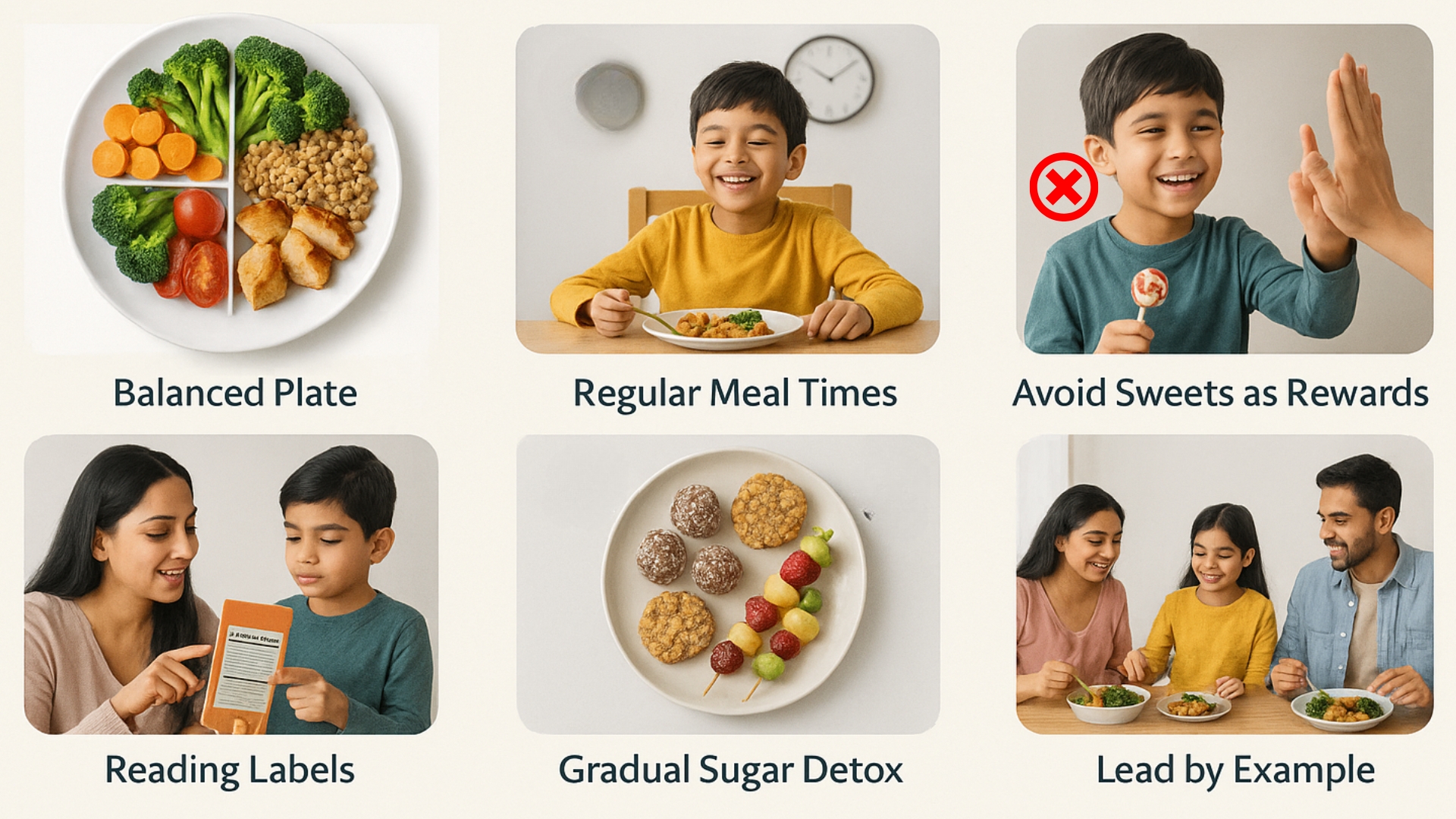
Avoid Using Sweets as Rewards or Bribes:
Using sugar as a tool to encourage behaviour links emotional comfort to sweet foods—feeding into the cycle of sugar cravings. Instead, reward your child with experiences, praise, or non-food-based treats.
Read Food Labels Carefully:
Even foods marketed as “healthy” may be loaded with hidden sugars. Granola bars, flavoured yogurts, cereals, and juices often contain high levels of added sweeteners. Learn to identify terms like maltose, corn syrup, and fructose—all culprits behind excess consumption of sugar. Swap these with non-processed sugar alternatives when possible.
Try a Gradual Sugar Detox:
Going cold-turkey can make sugar cravings even more intense. Instead, taper sugar intake gradually. Replace candies with fruit-based treats or opt for healthy snacks such as date balls, homemade ragi laddoos, or banana oat cookies. Slowly introducing better sugar substitutes like jaggery or honey in moderation can ease the transition.
Lead by Example:
Children model their eating habits after parents. If they see you making mindful choices and not giving in to your own urge to eat sweets, they’ll follow suit. Make family meals a space for learning and healthy exploration, using fun presentations and interactive cooking to keep kids involved.
These strategies not only help to control sugar cravings, but also support long-term health and better eating behaviour. The key lies in understanding the reasons for craving sugar and replacing empty calories with nourishing options.
Tasty & Healthiest Sugar Substitutes for Children
Reducing your child’s sugar cravings doesn’t mean eliminating all things sweet—it means making smart, delicious swaps that satisfy their taste buds without the excess consumption of sugar. The trick is to offer healthy snacks that are both nourishing and enjoyable. These natural and creative alternatives are perfect for kids who always crave sugar.
Naturally Sweet Fruits
- Nature’s original candy! Fresh fruits like banana, mango, berries, and dates are packed with fiber, vitamins, and antioxidants.
- These options not only satisfy the sugar cravings, but also support digestion and immunity.
- Dates, in particular, are better sugar substitute, ideal for baking or blending into smoothies.
Homemade Snacks That Kids Love
- Swap store-bought junk with homemade delights like date laddoos, ragi cookies, and fruit yogurt parfaits.
- These are fun to make with kids and serve as healthy snack that reduce sugar cravings.
- Ingredients like oats, millets, and yogurt help to control sugar cravings by offering sustained energy without the crash.
Smart Sugar Swaps
- Refined white sugar is the biggest culprit behind excess consumption. Instead, try non-processed sugar options such as:
Jaggery –
a mineral-rich sweetener perfect for Indian recipes.
Honey –
a natural antibacterial (in moderation).
Coconut sugar –
low on the glycemic index.
Nut butters –
peanut or almond butter add healthy fats and a sweet, creamy taste.
- These swaps are gentle on the body and a great start if you’re looking to reduce sugar intake gradually.
Healthy Beverages Over Packaged Juices
- Packaged juices are often loaded with hidden sugars—even the ones labelled “100% fruit.”
- Offer flavoured infused water with lemon, mint, or berries, or choose coconut water, which is naturally sweet, refreshing, and hydrating.
- These alternatives quench thirst and reduce the urge to eat sweets, especially on hot days or after physical activity.
When you incorporate these better sugar substitutes into daily meals, you help your child enjoy sweetness without the drawbacks of refined sugar. These simple choices go a long way in helping to reduce sugar intake and break the habit of always craving sugar.
Benefits of Reduced Sugar Intake in Children
Making the effort to reduce sugar intake in your child’s diet pays off in more ways than one. Beyond curbing sugar cravings, a lower-sugar lifestyle contributes to better physical, mental, and emotional health. The benefits of reduced sugar intake are both immediate and long-term—here’s how: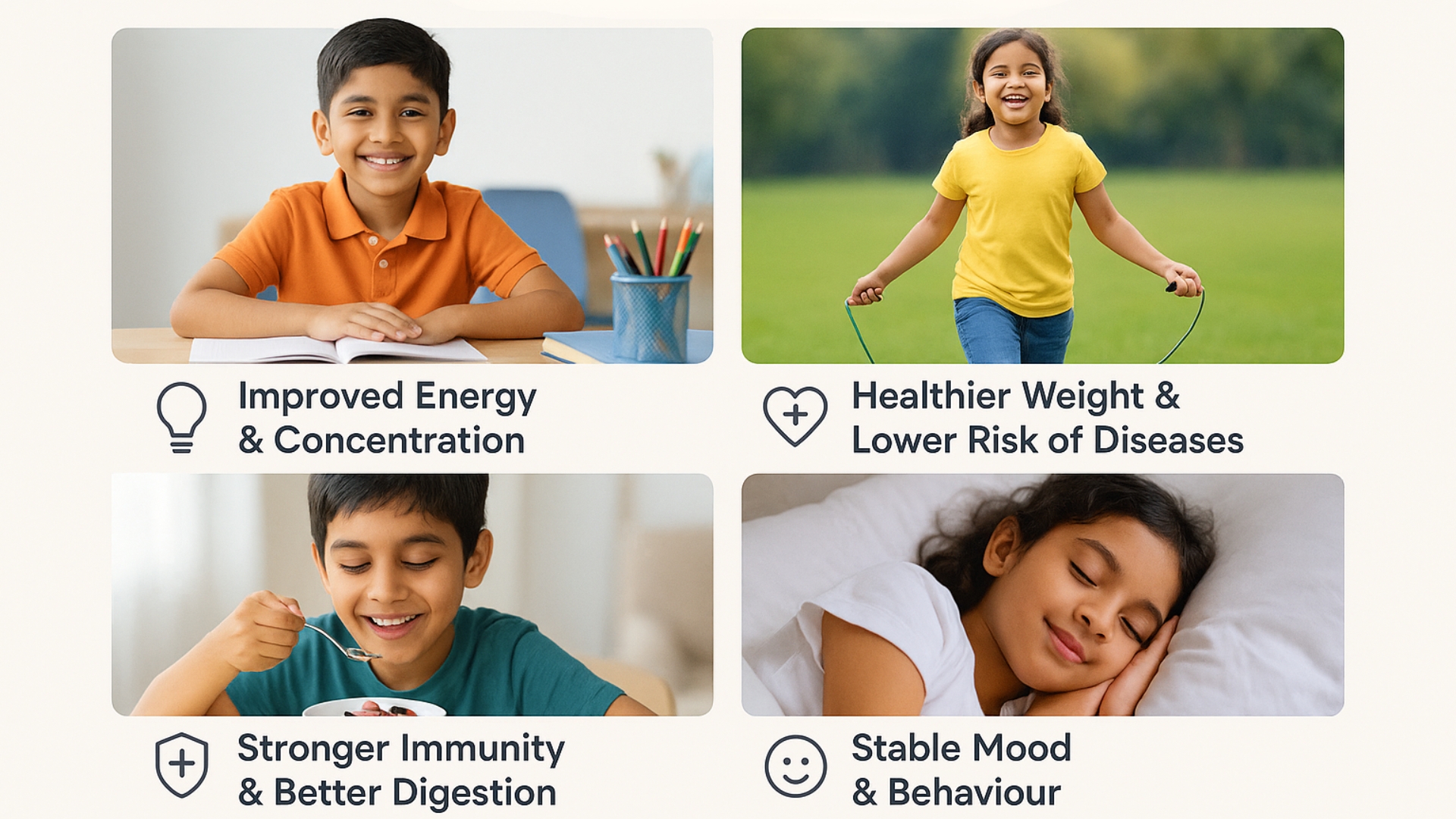
Improved Energy and Concentration:
When children consume less sugar, their energy levels become more stable. Unlike sugary snacks that cause rapid spikes and crashes, balanced meals help kids stay energized throughout the day. This directly enhances their concentration, focus, and academic performance. Managing sugar cravings helps reduce mid-day fatigue and restlessness in classrooms.
Healthier Weight and Lower Risk of Chronic Diseases:
One of the biggest benefits of reduced sugar intake is healthier weight maintenance. Excess sugar leads to fat storage and can increase the risk of early-onset obesity and type 2 diabetes. By learning to control sugar cravings, you’re helping your child prevent serious lifestyle-related conditions later in life.
Stronger Immunity and Better Digestion:
High sugar diets can suppress the immune system and harm the gut microbiome. When you reduce sugar intake, your child benefits from better digestion, fewer stomach upsets, and increased resistance to common illnesses.
Stable Mood and Fewer Behavioural Issues:
Sugar highs followed by sudden crashes can lead to mood swings, tantrums, and irritability. Children with managed sugar cravings tend to be more emotionally balanced, with improved sleep and calmer behaviour.
Making small changes today can bring lifelong rewards. Start by swapping out sugary treats for healthier options and support your child in developing habits that naturally control sugar cravings.
Fun & Engaging Ways to Encourage Healthy Eating
Let’s face it—telling a child to eat their veggies instead of a cookie rarely works. But when healthy eating becomes fun, it transforms into a habit they’ll actually enjoy. Encouraging children to choose healthy snacks and naturally reduce sugar intake is easier when you make it interactive, creative, and exciting!
Here are some joyful ways to guide kids toward better food choices—while quietly tackling those persistent sugar cravings:
Cook with Your Kids
- Invite them into the kitchen! Children are more likely to eat what they’ve helped prepare.
- Try kid-friendly recipes like fruit yogurt parfaits, no-bake date laddoos, or banana oat pancakes using better sugar substitutes like honey or jaggery.
- Cooking becomes an opportunity to introduce foods that reduce sugar cravings while spending quality time together.
Play the “Rainbow Plate” Game
- Make mealtime a visual adventure by challenging kids to fill their plates with colourful fruits and vegetables.
- Reward creativity with stickers or points instead of candy—helping to break the cycle of using sweets as motivation.
- These vibrant meals are naturally rich in fiber and antioxidants that help to control sugar cravings.
Bento Box Magic
- Transform school lunches with bento boxes that include bite-sized, nutrient-dense foods arranged in fun shapes, characters, or themes.
- Include items like cheese cubes, cucumber stars, fruit slices, and peanut butter on whole grain crackers.
- Bento boxes reduce the urge to eat sweets by offering variety and excitement without relying on sugary snacks.
Create Positive Associations
- Instead of punishing children for wanting sugar, help them understand why we should reduce sugar intake in a way that empowers them.
- Share how too much sugar can lead to tiredness, tummy aches, or even affect their school performance—all outcomes of excess consumption of sugar.
- Let them explore non-processed sugar options and “taste test” natural treats to discover new favourites.
Healthy eating should never feel like a chore. With these interactive strategies, you’ll not only control sugar cravings, but you’ll build a joyful food culture that lasts a lifetime.
FAQs
Q1. Why does my child always crave sugar?
Children often always crave sugar due to a mix of biological instincts, emotional triggers, and environmental influences like ads and processed snacks. Understanding the reasons for craving sugar helps in managing it better.
Q2. What are the health risks of excess consumption of sugar in kids?
Excess consumption of sugar can lead to childhood obesity, early-onset diabetes, dental issues, and even behavioural problems like hyperactivity or poor focus.
Q3. What are the best foods that reduce sugar cravings in children?
Whole fruits, nuts, yogurt, whole grains, and high-fiber foods are excellent foods that reduce sugar cravings and support stable energy levels.
Q4. Are there better sugar substitutes for kids?
Yes, better sugar substitutes like dates, honey (in moderation), jaggery, and non-processed sugar options like coconut sugar are safer and more nutritious for children.
Q5. How to reduce sugar intake without making kids feel deprived?
The key to reduce sugar intake is by gradually replacing sugary snacks with fun, tasty, and healthy snacks like fruit parfaits or ragi cookies.
Q6. What causes sugar cravings at night in children?
Sugar cravings at night may occur due to unbalanced meals during the day, emotional comfort-seeking, or irregular sleep and eating patterns.
Q7. Can stopping sugar intake really help my child lose weight?
Yes, stopping sugar intake can help in managing weight more effectively and improve metabolism in children.
Q8. What are some healthy snacks for sweet cravings my child will enjoy?
Options like banana oat cookies, date laddoos, yogurt with berries, or apple slices with nut butter are ideal healthy snacks for sweet cravings.
Conclusion
When it comes to children’s nutrition, knowledge is power—and small, consistent steps lead to big results. By understanding the root of your child’s sugar cravings and replacing them with smarter choices, you’re already on the path to long-term wellness.
The formula is simple: Awareness + Smart Substitutes = Long-Term Health.
We now know that excess consumption of sugar doesn’t just affect weight—it impacts energy, mood, learning ability, and immunity. Tackling this doesn’t mean eliminating all sweetness, but rather introducing healthy snacks for sweet cravings, and choosing better sugar substitutes like fruits, jaggery, or non-processed sugar options.
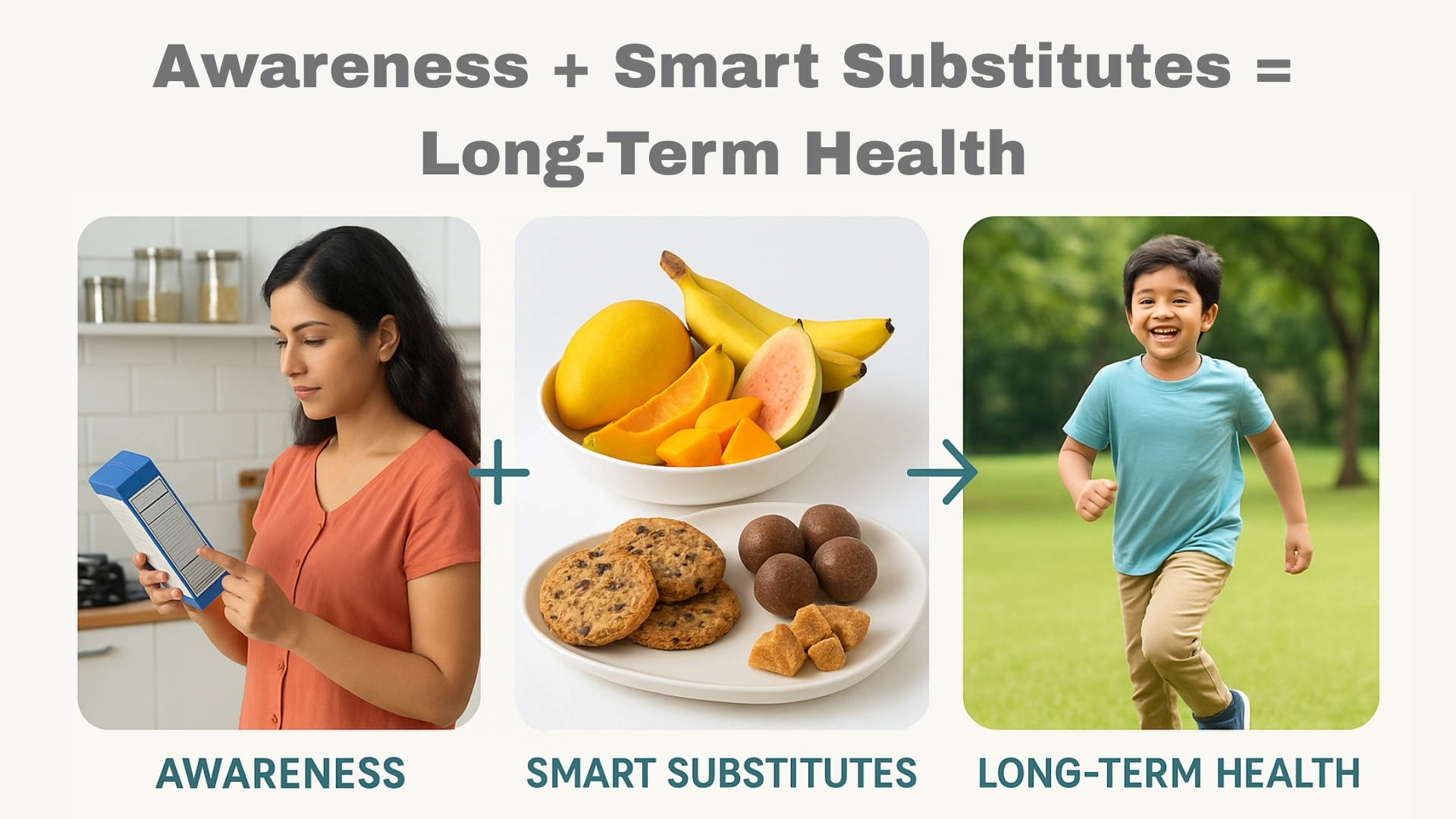
By offering foods that reduce sugar cravings and helping your child develop a love for balanced, colorful meals, you’re laying the foundation for a future of mindful eating. Every time you skip that soda or avoid that packaged treat, you make a difference. Every fruit bowl and homemade snack chips away at the urge to eat sweets. It all adds up.
If you’re overwhelmed trying to figure out how to reduce sugar intake, you don’t have to go it alone.
At MotoNutrition, our expert pediatric dietitian, Deepti Gupta, is here to guide you with personalized plans, delicious recipes, and family-friendly strategies that truly work. Let us help you control sugar cravings the smart, sustainable way. Ready to take control of your child’s sugar intake? Connect with us today and take the first step toward healthier, happier habits!
For more information, go to our Homepage.